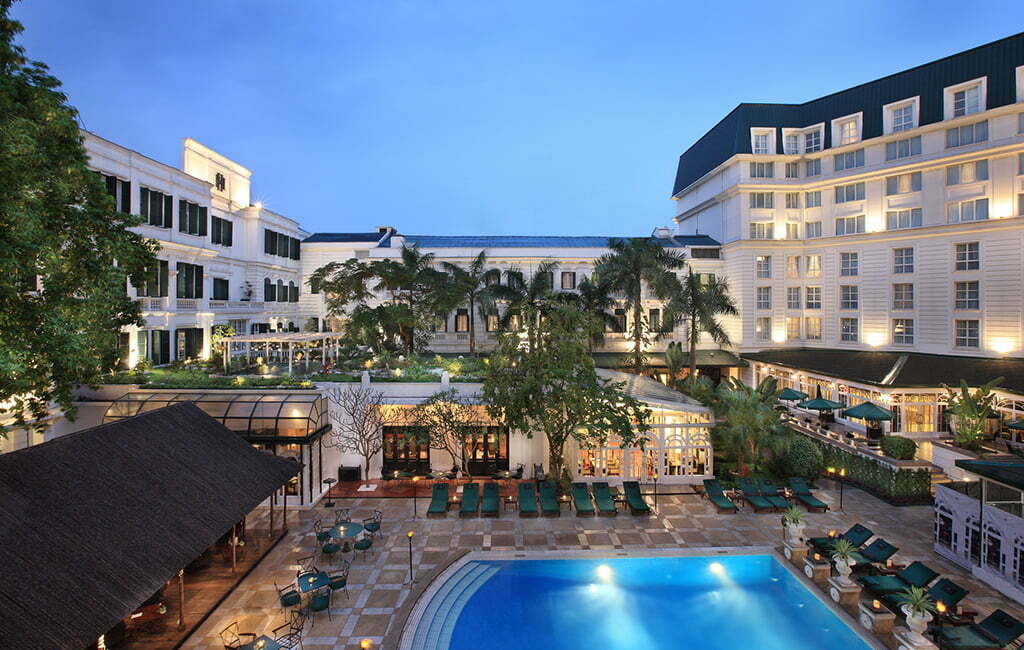Hanoi, an essential destination and the capital of Vietnam, where “Vietnamese life” blends with the colonial past. Scooters reign supreme in the heart of a labyrinth of alleys crowded with small stands, various shops, and street food stalls.
The congestion on the sidewalks is a true spectacle! Clothing vendors, small low tables and stools for dining, children playing, artisans, etc. Cyclo-rickshaws navigate through the streets of old and specialized quarters by profession.
The colonial quarter, with its beautiful yellow buildings lining wide avenues, recalls Hanoi’s colonial history. The beautiful Hoan Kiem Lake in the center is the lungs of Hanoi and the meeting place for strolling in the shade of tall trees, shopping in luxurious boutiques, or practicing Tai Chi amidst the early morning crowd of Hanoians.
Our agency, Hanoi Voyages, located in Hanoi, is proud to have over 15 years of experience. We are a leader in the market for private individual travel, with a private vehicle, driver, and guide.
The One Pillar Pagoda is very attractive due to its impressive architecture. It is attached to the legend of King Ly Thai Tong. It is built in the shape of a lotus flower emerging from the water by a single pillar in the center.


It is one of the most visited places in Hanoi. It houses the remains of the founding father of independent Vietnam, displayed in a crystal coffin.
Don’t miss out on this unforgettable experience, join us as we delve into the heart of Vietnam’s heritage.
Dedicated to the worship of Confucius and the Literati. Built in 1070, it was first the 1st University of Vietnam reserved for the social elite who learned Confucian thought and morality. Then democratization allowed all social classes to follow this teaching. It is one of the few almost intact temples of that time.

The Museum of Ethnography, the result of French-Vietnamese cooperation, is a wonder. The museum is divided into two parts: an exhibition is held inside and the other is outdoors.
Inside, a dozen rooms allow nearly 2,500 objects representing the life and culture of the 54 ethnic minorities of Vietnam to be displayed. Photo exhibitions and small explanatory films retrace the customs, explain weaving, crafts, costumes, and different ethnicities.
Outside, the traditional houses of the different ethnic groups are reconstructed. Bahnar house, Ede house, Tay stilt house and Jorai tomb.
Quan Thanh Temple (formerly known as Tran Vu Temple) is an 11th-century Taoist temple dedicated to Tran Vo, one of the main deities of Taoism, to protect the capital from evil spirits from the north.
The large and beautiful shaded courtyard houses a giant banyan tree and the famous bronze statue of Tran Vo.
Built in the 6th century in Hanoi, this is the oldest pagoda in the city. Particularly beautiful at sunset, it is highly revered by the locals and is nicknamed “Defense of the Fatherland.”
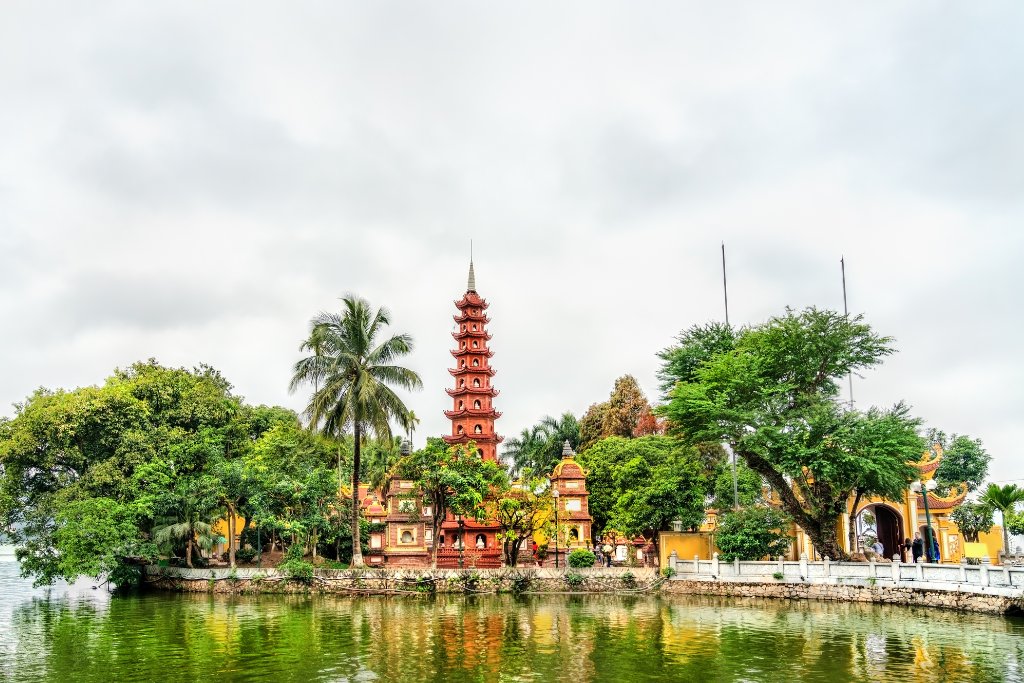

The train that runs from Hanoi to Ho Chi Minh travels along this narrow street, which is closed to cars. Located in the old quarter, it is a surprising attraction! The houses are very close to the tracks, about 1.5 meters away, but small shops and cafes still operate.
As the train passes at regular intervals, they clear the tracks when the train announces its arrival. This surprising and unusual situation has made the street very popular!
This museum honors VIETNAMESE WOMEN. It is a beautiful representation of women in Vietnam, highlighting their roles both “in times of war” and “in times of peace.” Brave soldiers, they defended their country as valiantly as men. During peacetime, Vietnamese life is portrayed through women, including customs, traditions, family life, etc.
Vietnamese lacquer is Vietnam’s great artistic specialty. Your guide will explain all the steps involved in creating a high-quality lacquer, including inlaid mother-of-pearl, eggshells, etc.
The Lake of the Returned Sword, called Ho Hoan Kiem-Ho Guom in Vietnamese, with the Ngoc Son Temple nearby, has a legend associated with it involving the emperor Ly Thai To, a magical sword, and a giant golden turtle! The Ngoc Son Temple is famous for the Huc Bridge and the Pen Tower (Thap But).
In the heart of Hanoi, this lovely setting, combined with the beauty of lush nature, colorful gardens, and majestic trees, is a true place of life. Early in the morning, Hanoians practice tai chi or yoga, and in the evening, they stroll in the cool air while enjoying ice cream or relaxing on a terrace with a Hanoi beer.
Founded in 1889, the Dong Xuan covered market occupies four floors in the north of Hanoi’s old quarter. It is the largest covered market in Hanoi, selling fresh produce, souvenirs, accessories, clothing, and household appliances. Local exotic dishes are also served there at very reasonable prices.
Located at 87 Ma May Street, this 19th-century traditional Vietnamese architecture house has all the features of old tube houses in Hanoi where people lived and did business. On special occasions such as national holidays or the Mid-Autumn Festival (the 15th day of the lunar calendar in August), this house hosts performances of traditional arts of Hanoi.
Built in the 19th century by French colonists on the site of the Bao Thien Pagoda, which was built during the Ly Dynasty. A true example of neo-Gothic architecture, it is one of the must-visit monuments in Hanoi.
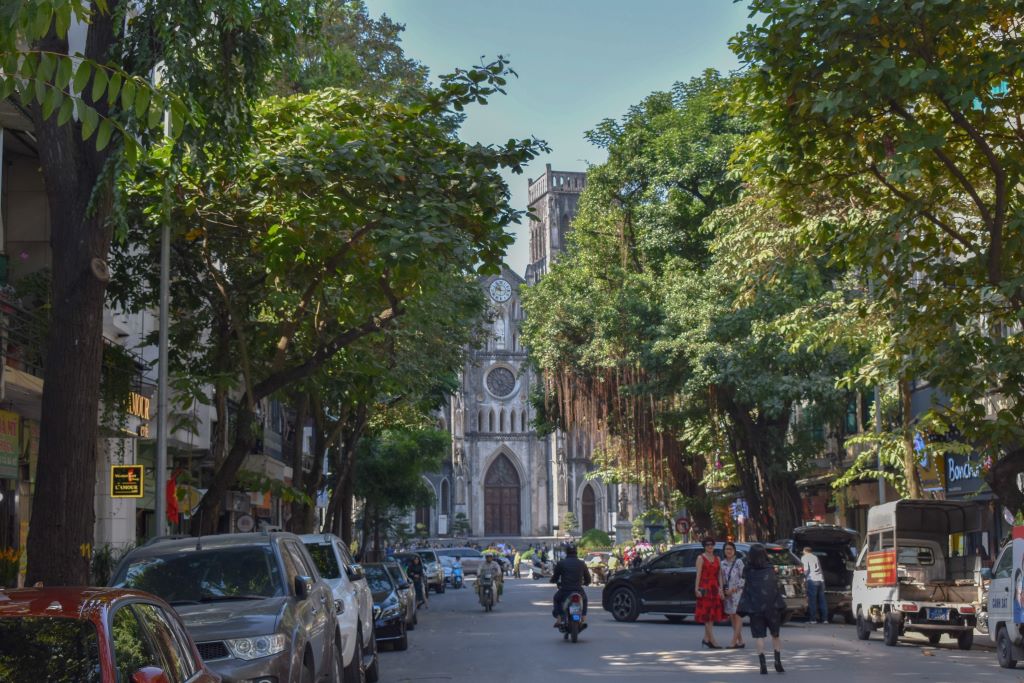
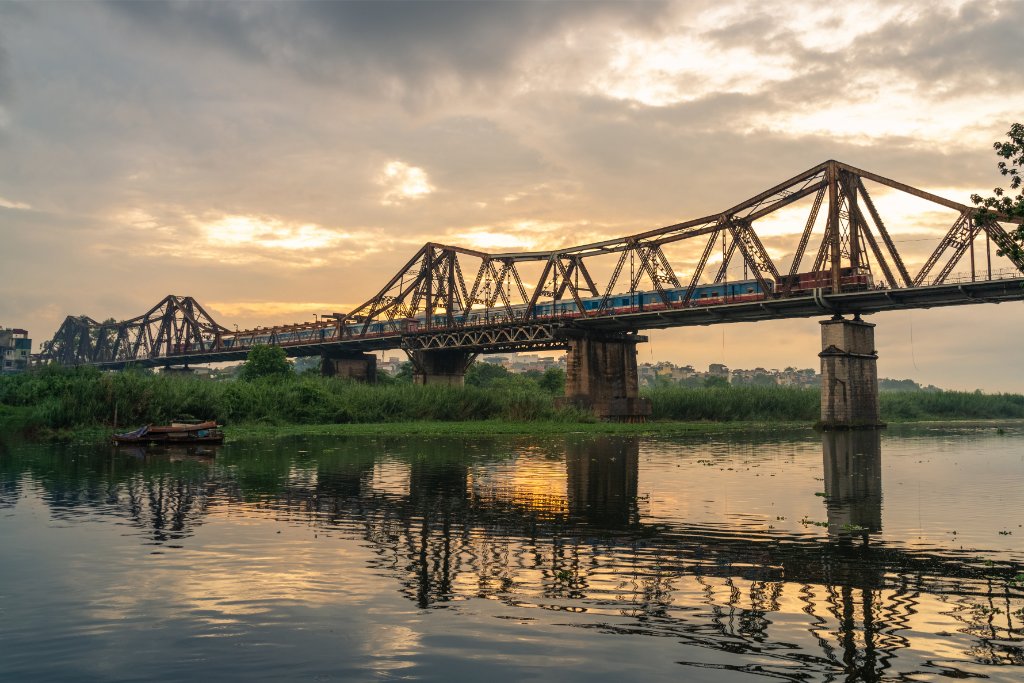
The Long Bien Bridge, also known as the “Paul Doumer Bridge,” was constructed between 1899 and 1902 and designed by Gustave Eiffel, the same architect who designed the Eiffel Tower in Paris.
This bridge crosses the Red River and connects the two districts of Hoan Kiem and Long Bien. At night, the bridge is illuminated with colorful lights.
Also known as the “White Horse Temple.” It is the oldest Buddhist temple in Hanoi, built in the 9th century by King Ly Thai To in honor of a white horse (Bach Ma). Beautiful ancient wooden doors open to reveal a rich interior decoration of red lacquered wood, including a magnificent red funeral palanquin and a sanctuary dedicated to Confucius.
Located in the heart of Hanoi near the Opera and Hoan Kiem Lake, the National Museum of Vietnamese History was established in 2011 by merging the National Museum of Vietnamese History and the National Museum of the Vietnamese Revolution.
It houses a large collection of precious objects and documents covering the period from Dong Son until the declaration of Vietnam’s independence in 1945.
This museum presents a rich collection of war weapons, tanks, and airplane debris, tracing the periods of wars.
Hoa Lo Prison is one of the darkest chapters in the country’s history. It was built by the French in 1890 and became a symbol of their repression of the Vietnamese population during the colonial period.
During the Vietnam War, Hoa Lo Prison also housed American pilots, including John McCain.
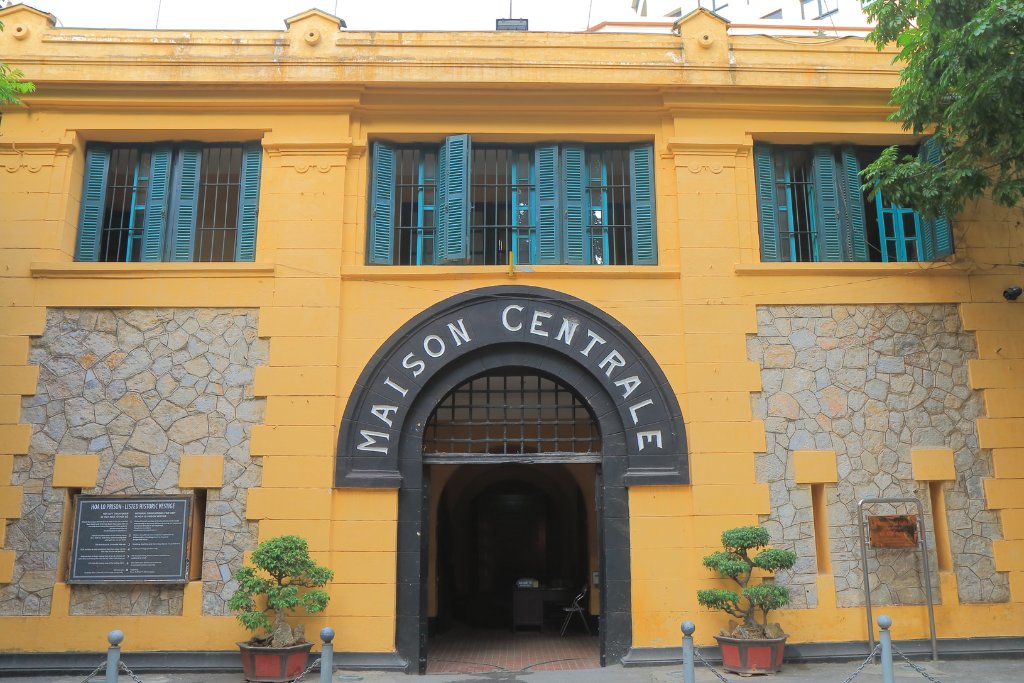
Located near Hoan Kiem Lake in Hanoi, the neoclassical Hanoi Opera House was built in 1911 by the French and imitates the Opera House in Paris in its structure and interior spaces. Various performances are held there, including the popular “My Village” show.
This elegant French architecture building was constructed in 1901 and renovated in 2013. Trang Tien Plaza is a high-end shopping center that houses many famous international brands such as Dior, Cartier, Bvlgari, Louis Vuitton, and more.
Every weekend from 8:30 pm, the area becomes pedestrian-only. It stretches for 3 km from Dong Xuan Market, along Hang Dao Street to Hoan Kiem Lake. Local products are inexpensive and attract a large crowd.
We honor our traditional villages that reflect our culture and our craft villages dedicated to our varied and captivating handicrafts. You will be taken behind the scenes where the artists at work will amaze you. Patience, skill, creativity, originality – an entire universe to educate and charm you.
In some souvenir shops, you will have the opportunity to discover this craft that arouses great curiosity. The workshop you will visit is run by the owner, a young physically disabled woman whose joy of living and cheerfulness are reflected in her little masterpieces.
Paintings or cards made of very thin rolled and shaped paper ribbons, like a painting. A mosaic of colorful images of Vietnam such as Vietnamese women in Ao Dai on bicycles, sampans, pagodas, fishermen, junks, are reproduced with talent and truth.
This is where prints, a cultural symbol of a very popular art in Vietnam for centuries, are produced. They have long been part of the life of the Vietnamese people and serve as decoration in households during Tết. Prints depict scenes of ordinary life, landscapes of Vietnam, seasons, symbols of prosperity, fabulous animals drawn from mythology, genies from popular beliefs or divinities: dragons, unicorns, phoenixes, Buddha and his disciples, etc.
The prints are made with wood and on a specific paper also made here from the Ne tree. The paint is organic and applied to the wood before being pressed onto the paper. The process is repeated with different colors.
Rich in historical and cultural relics, including those of the Ly dynasty. Typically Vietnamese, this show consists of songs accompanied by traditional musical instruments.
A vocal art that is a true cultural heritage. Songs with sentimental lyrics, full of emotion. The richness of the melodies, the vocal qualities of the singers, their elegance, are the components of this original and typical show of Vietnamese culture.
You will travel through Bat Trang in an ox-drawn cart. Bat Trang is located on the left bank of the Red River, about fifteen kilometers from Hanoi. It has long been renowned for the quality of its ceramics. From traditional style to modern, sleek, and very design lines, Bat Trang will satisfy your curiosity, and you will be amazed to discover with what precision the painters decorate the objects.
It was in Bat Trang that the artist Le Minh Ngoc produced a vase 3.20 meters high and 0.94 meters in diameter, 170 kg, registered in the Guinness of Vietnam in 2002.
This village has always been renowned for its fine wood carving work on ebony. The main activity of this village is the production of carved furniture with mother-of-pearl inlays and considerable-sized decorative paintings.
Carved and sanded shells are meticulously inlaid to depict scenes of flowers, lovely landscapes with rivers and small bridges, characters, and animals, demonstrating the artistic sense, meticulousness, and patience required for such artistic activity. You will be conquered!
Quy are extremely fine gold leaves used for artistic purposes, either on religious statues, inlaid on lacquer objects, on paintings, or on frames gilded with fine gold. You will discover the various laborious steps before being able to meticulously use the light-as-air thin gold leaf sheets, which are mostly applied with a brush. This informative visit will fill you with admiration for this particular craft.
Departure for a day trip to the Perfume Pagoda, a complex of pagodas and a Buddhist pilgrimage site located about 70 km southeast of Hanoi. Upon arrival, board a sampan for a small cruise on the Yen River to the Thien Tru Pagoda. During your walk, the boat stops to visit the Den Trinh temple and some pagodas. Upon arrival, have lunch before climbing a hill to reach the Giai Oan Pagoda and the Huong Tich Cave.
Early departure for Duong Lam. Upon arrival, discover the Mong Phu village (possibility of cycling) and its ancient red laterite and rammed-earth houses. This authentic small village has preserved its village gate, communal well, and temple courtyard. Enjoy a pleasant walk in the peaceful atmosphere of the village. Have lunch at a local and family-owned establishment. Continue by car to the Thay Pagoda and the Tay Phuong Pagoda.
If you need information on a specific tour, we highly recommend the following tour: Discover Vietnam’s Natural Beauty 18 Days.
Take a ride to explore Hoan Kiem Lake and its legend, Ngoc Son Island and its beautiful temple in the middle of the lake. Navigate the bustling streets of the famous and fascinating “Old Quarter of the 36 Corporations” and visit the famous Silk Street (Hang Gai). If you continue your trip to Vietnam to the central regions of Hue and Hoi An, you will also have the opportunity to discover the city by cyclo.
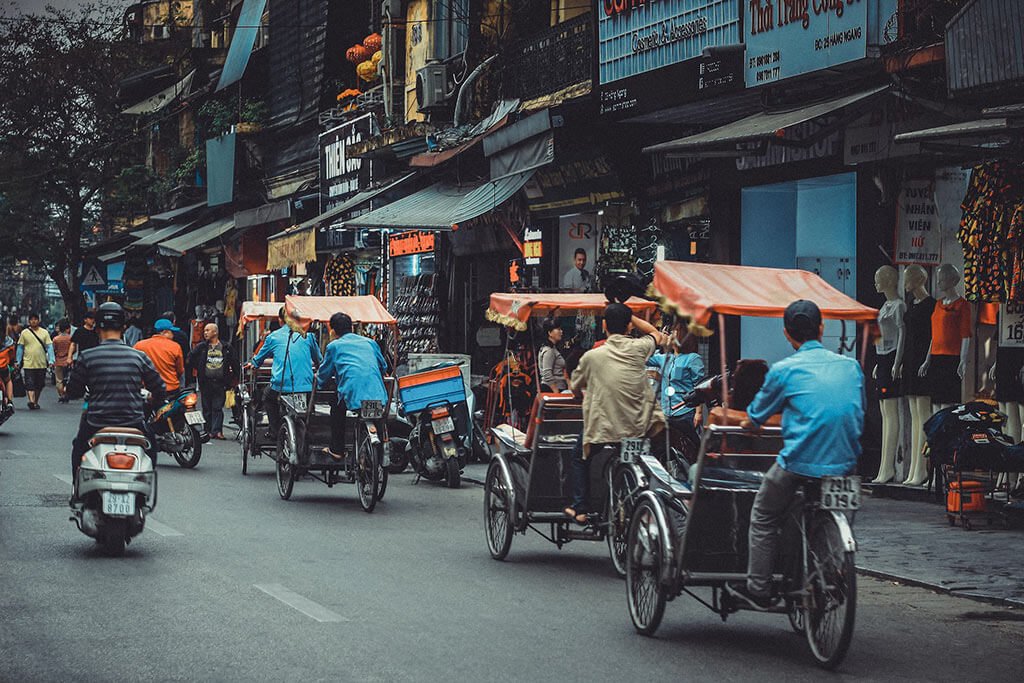
Follow us to the end of a small alley to an oasis of greenery where little birds chirp and fruit trees and flowers abound. Here, the love for the beautiful and delicious traditional cuisine of Hanoi is embodied. The hostess, accompanied by the women of the family, will guide you in preparing a complete menu that you will then enjoy in the charming setting of this lovely home.
Hanoi has just received an award in honor of its culinary specialties. If you enjoy tasting the culinary specialties of Hanoi and our country and want to fully immerse yourself in Vietnamese ambiance, we will be pleased to take you to one of our favorite establishments.
Pho (beef noodle soup), Cha Ca (La Vong fried fish paste), Bun Cha (grilled pork with rice vermicelli), Banh Da Cua (crab noodle soup), Mien Luon (vermicelli soup with swamp eels), Banh Com (glutinous rice cake), and O Mai (dried fruits). Don’t forget to indulge in delicious steamed or grilled seafood, consumed in a local and relaxed atmosphere!
This drink is a specialty unique to Hanoi that originated in the 1950s. The story goes that at the time, due to a lack of milk, the owner developed a recipe based on eggs. And the success was there! It is a hot drink where the aroma of coffee and the finesse of the egg-based preparation mix harmoniously.
Immerse yourself in Vietnamese culture and visit a traditional and popular street food stall in our address book to discover the unique flavors of the Hanoian specialty called Pho.
The water puppet show is accompanied by a choir and traditional Vietnamese instruments. It features excellent and talented artists who present a delightful and typical Vietnamese cultural spectacle that showcases the legend of the dragon and various scenes depicting rural life. It is both simple and humorous, beautiful and tasteful, and uniquely local. It is definitely worth seeing!
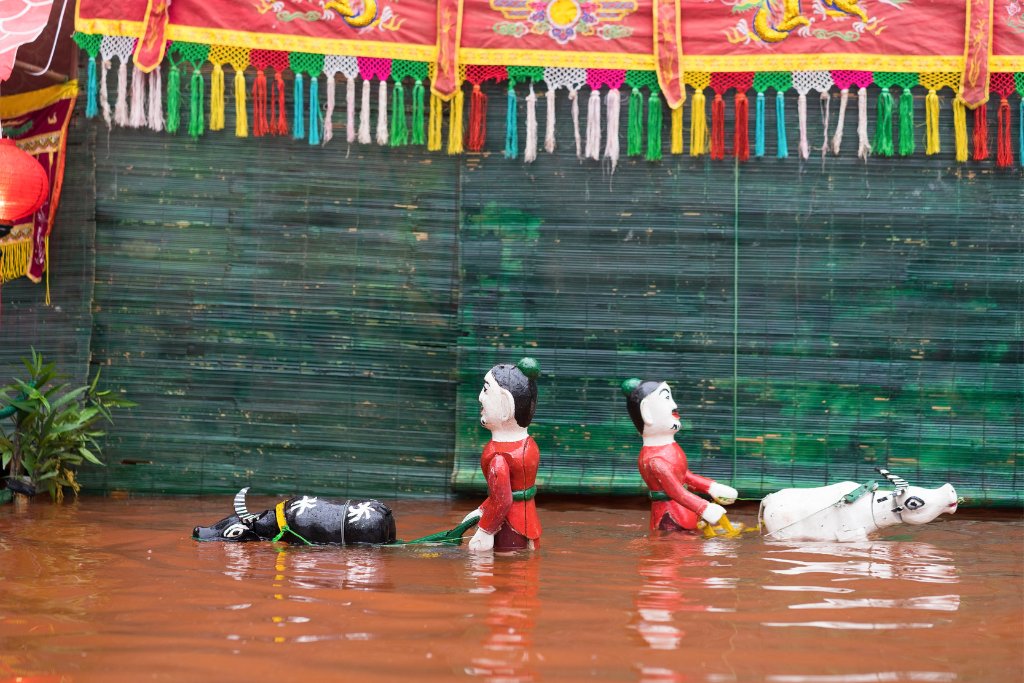
The “My Village” Vietnamese circus show is a 60-minute performance full of gentle and emotional acts. It is an unprecedented and breathtaking show that features an acrobatic troupe performing on giant bamboo poles to the rhythm of live tribal music. This show has been recognized as a cultural heritage by UNESCO.
Calligraphy, or Thu Phap in Vietnamese, is the art of forming handwriting characters beautifully. At the Temple of Literature, a private calligraphy class organized by Hanoi Voyages offers an opportunity to meet a professional calligraphy master and learn about this exceptional art. You can create your unique piece of calligraphy art to take home as a souvenir of your Vietnam adventure.
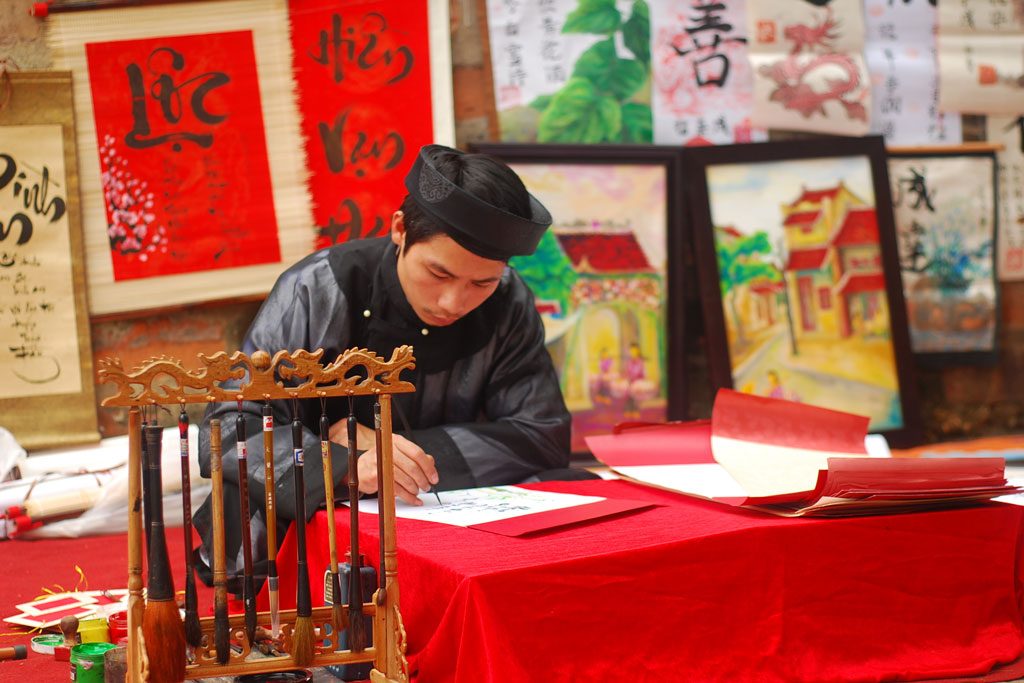
Hanoi is full of small shops with colorful facades, second-hand stores, and fashion stores that offer attractive prices for both children and adults.
Spa centers and hotels, massage and beauty salons offer a wide range of services at the price of a Starbucks coffee.
At night, Hanoi reveals another side of its personality and offers various activities to do alone, with family, or friends. When the sun goes down, “bia hoi” is a safe haven for beer lovers. This drink is served unlimitedly during meals and allows everyone to quench their thirst at a low cost.
Afterward, bars and nightclubs open their doors. Although the hours are relatively short, the experience of Hanoi’s nightlife is exceptional.
The northern region of Vietnam, including Hanoi and Sapa, has a wet season from May to September and a dry season from October to March.
In January and February, the temperature ranges from a minimum of 10 to a maximum of 15°C. In the high mountains of Sapa, there can be frost and fog during this time. In March and April, the temperature ranges from 17 to 25°C, and there is relatively little rain with mostly cloudy skies.
In May, temperatures rise to around 20 to 30°C, and beyond that, the temperature continues to rise, with more rainfall, especially in July and August. September is slightly less rainy. In October and November, the temperature decreases to around 25°C, and the rainfall decreases.
For first-time visitors to Hanoi, the best place to stay is the Old Quarter, also known as Hoan Kiem, which offers a wide variety of hotels, restaurants, and street food to choose from.
This luxury hotel is located in the heart of the Old Quarter and provides an elegant and refined environment after a good day of walking. With modern materials, precious decor, and friendly staff, this peaceful haven continually offers excellence to its guests. The hotel is 300 meters from the Old Town gate, 500 meters from Ngoc Son Temple and Dong Xuan Market, and 21 km from Noi Bai International Airport. It is ideally located to explore the city and discover its wonders.

Located in the Old Quarter of Hanoi, the Hanoi Pearl Hotel has received a certificate of excellence for its quality service and refined rooms. This 4-star hotel with undeniable charm and luxury offers its visitors calm and serenity for a few days, with staff who go above and beyond to meet any requests.
Located on one of the liveliest streets in the Old Quarter, the Chi Boutique Hotel Deluxe is full of charm and will delight you during your stay in Hanoi. Fully equipped with modern rooms and suites, this classy and refined hotel has a warm and trained staff to meet all your expectations! To perfect your stay, the hotel has a rooftop bar with a splendid view of the city, especially at night!
Hanoi is a charming and magical city. We hope that the Sofitel Legend Metropole Hanoi, with its unique identity, rich history, and classic romance, will make your trip to Hanoi even more special. Discover our elegant French-Vietnamese art of living and enjoy this wonderful space.
